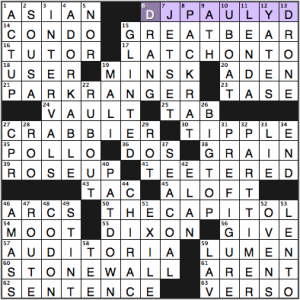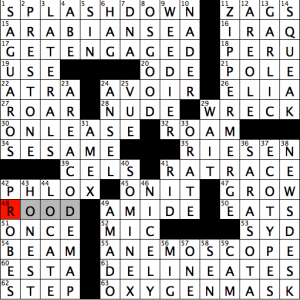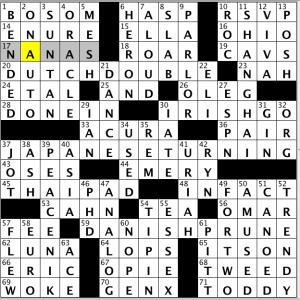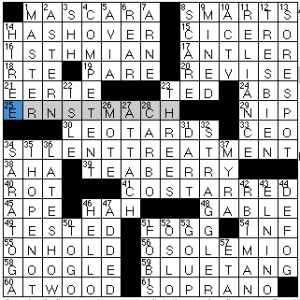Newsday 17:50 (Amy)
NYT 5:37 (Amy)
LAT 3:55 (Andy)
CS 6:15 (Dave)
Kyle Dolan’s New York Times crossword
Wow, I knew that Jersey Shore had a Pauly D dude, and possibly that he was spinning a DJ career out of his reality-TV fame, but not that the moniker DJ PAULY D (6a. [“Jersey Shore” housemate’s music-biz name])was a thing. No idea if this means the at-the-club or on-the-radio type of DJ (and if you know, please don’t tell me; I know too much already). In the 6-Across space, we would also have accepted ST. PAUL, MN.
Favorite clue: 26d. [Three-ring setting], because I didn’t fall for the CIRCUS trap and filled in BINDER, thanks to the B in TAB. And then it turned out to be the BIGTOP after all.
Second favorite clue: The oddballness of signaling ASIAN with 1a. [Like cork trees and flying lizards]. I was tempted by the answer but moved elsewhere in the puzzle right off the bat because I was not at all certain that ASIAN would be right.
Top fill:
- 50a. [House meeting place], THE CAPITOL.
- 60a. [Be an unhelpful interrogee], STONEWALL. We would also have accepted [Birthplace of the gay rights movement].
- 4d. [Like cute nerds, in slang], ADORKABLE. The word was first applied most prominently to Zooey Deschanel’s character on New Girl. With bangs. And cutesy dresses. And, apparently, a certain nerdiness.
- 8d. [Keeping buff?], PACK RAT. Love this great clue! One who is a buff/fan of keeping too much stuff.
- 31d. [Foreshadow], PREFIGURE. I like that word. So sue me.
- 40d. [Touching scene at an airport?], PAT-DOWN. Creepy, both clue and answer—but fresh for a crossword.
Place-name trivia I didn’t know:
- 19a. [Where Lee Harvey Oswald was a lathe operator], MINSK.
- 20a. [City where some believe Cain and Abel are buried], ADEN.
I wonder how many people hit 15a. [Big Dipper’s setting] without any letters in place (or with only the 2nd or 8th letter) and filled in URSA MAJOR instead of GREAT BEAR.
Thing I’ve never, ever heard of: 37d. [Constituent of molding sand], SEA-COAL. Also: What’s molding sand? To the Google! Molding sand is used in sand casting, and it also contains bentonite clay (which I also know nothing about).
Another thing I don’t know anything about is the battle of the St. Lawrence (10d. [Raider in the battle of the St. Lawrence]). A U-BOAT? Is this the St. Lawrence Seaway? More or less—the St. Lawrence River and the Gulf of St. L. German U-boats sinking Canadian ships. I bet our Canadian friends are better versed in this bit of history.
3.75 stars.
Barry C. Silk’s Los Angeles Times crossword—Andy’s review
The grid for this one made it very difficult to solve smoothly: it’s very nearly split into two halves, connecting only at the S of CELS/SOMINEX and the R of WEEDIER/ROAM. I found myself jumping from section to section, starting in the NE, going into the S, moving back toward the SE, back up into the N, then to the NW, and finally to the SW. This recap would be much easier with a telestrator, probably.
Hit parade: ZIPPER MERGE, OXYGEN MASK, AREA CODE MAP, SPLASHDOWN, RIESEN (yum!), ANSEL clued as [Adams of film?] (not Amy), SOMINEX, PERU (Indiana), SAGUAROS [Sonoran Desert natives]. I also liked seeing Jorge AMADO in the grid [“Dona Flor and Her Two Husbands” author], but I’m guessing he’s not the most popular entry in today’s puzzle. PHLOX is never a gimme for me. I should probably go learn something about it.
ANEMOSCOPE rubbed me the wrong way, but maybe I’m just bitter because I put ANEMOMETER at first. The puzzle felt more science-heavy than usual, which I liked: I’m counting PHLOX, SAGUARO, and ANEMOSCOPE among science entries, along with ECOTYPES, AMIDE, and perhaps SOMINEX. If you don’t know your sleeping aids, nitrogen compounds, Greek prefixes for “wind,” and Brazilian authors, then the south section of this grid was probably a bear.
In the “didn’t know that” category, see James OSGOOD [whose company published the first U.S. edition of “The Prince and the Pauper]. Apparently Osgood was friends with Mark Twain, and his publishing company would eventually become the New York branch of Houghton Mifflin.
Fine, but not my favorite. A highly subjective 3.5 stars. Until next week!
Tony Orbach’s CrosSynergy / Washington Post crossword, “National First” – Dave Sullivan’s review
Unusual (not sure in a good way, let’s see how it goes as I go through the theme answers) theme where two-word phrases that end with a nationality are reversed:
- [Doppelganger in Den Haag?] clued DUTCH DOUBLE. I enjoyed the Germanic “doppelganger” with the Dutch reference–“double dutch” is a type of jump roping when you have two ropes going.
- [Green light in Dublin?] clued IRISH GO. The base phrase “Go Irish!” comes from the Fighting Irish of Notre Dame. The made-up phrase here seems xenophobic at best and scatalogical at worst.
- [Lathe work in Kyoto?] was JAPANESE TURNING. The original source of this one is from this song by The Vapors, I believe.
- [Pied-à-terre in Bangkok?] clued THAI PAD. Pad Thai is a type of noodle dish; I enjoyed the turn of this phrase.
- [Withered one in Odense?] clued DANISH PRUNE. I suppose “peach” would’ve worked as well.
Points for originality, but demerits for some awkward results. Kind of expected to find DRESSING RUSSIAN or DRESSING ITALIAN in the mix, both I would’ve preferred to the Japanese entry. [Junk-filled seaport] referred to “junks” as boats, and was my FAVE clue, especially in an internationally-themed puzzle such as this. Speaking of things nautical, [Plied, as a dugout] referred to another type of boat, CANOED. Not as excited about I ATE and SUNTAN, the latter is generally just called a “tan,” unless it’s the spray-on type.
Stan Newman’s Newsday crossword, “Saturday Stumper”
I can scarcely believe I made it through this puzzle alive, sans Googling. It was hard, people. As hard as a diamond. (Your mileage may vary. If you found this to be a standard level of Stumper difficulty, give yourself a vigorous pat on the back, and also a cookie. You deserve it.)
Among the many things that I had to struggle to get, letter by letter, hazarding guesses and puzzling things out:
- 1a. [Word from the Catalan for “soot”], MASCARA. Makes perfect sense. What’s black and has a sort of Spanish-sounding name? Had no idea, though.
- 16a. [Person from Panama], ISTHMIAN. Person from an isthmus? Who knew? Never saw this word before.
- 23a/23d. [Common news group, supposedly], TED, and [Common news groups, supposedly], THREES. Neither clue makes a lick of sense to me. Explanation(s), anyone?
- 33a. [Chart topper], CEO. Topping the organizational chart.
- 39a. [Oil of wintergreen source], TEABERRY. I gambled on this because there’s a Teaberry chewing gum; had no idea if there was any wintergreen connection.
- 60a. [First Arthur C. Clarke Award winner], ATWOOD. The award’s for the best sci fi novel published in the UK and it began in the late ’80s. The Handmaid’s Tale is creepy but it hardly seems like sci fi anymore.
- 11d. [What anchors engender], RELIANCE. As in … the anchor on a tug-of-war team?
- 26d. [“This Cosmos in which we float like a __”: Sagan], MOTE. Makes perfect sense, but I didn’t know the quote and it took forever to suss out the word.
- 37d. [Winona Ryder’s role in “Great Balls of Fire!”], MYRA. Was stuck trying the five vowels and figuring out it could be a Y was a key advance in trying TEABERRY.
- 57d. [__], ETA. Is there something missing from this clue? Is a pair of underscored spaces somehow equivalent to the greek letter eta?
Since I did manage to finish the puzzle correctly without looking anything up, I can’t say that it’s unfair, but I can also imagine that if I’d been even a tiny bit tired or out of sorts, I would have had a DNF (did not finish). None of the fill is bad fill (and some of it’s excellent—the zippy SILENT TREATMENT, ERNST MACH‘s full name, BLUE TANG, “I HOPE NOT,” LATE SHOW, STRAGGLER, SORE SPOT, TRES BIEN), but Stan may have gone a little overboard on clue stumpification this week. Four stars, maybe 4.25.




NYT: A good puzzle marred by trivia gridlock in the NE corner. 10d, 11d, 12d, 13d, 20a and the endings of 5a and 15a, all had knowledge-based cluing or answers that I didn’t know. Now some may say I should know some of those things which is an acceptable response; others that some are inferable which is also acceptable but with which I disagree. But neither change the fact that the NE corner is a test of knowledge not crossword skill.
I don’t understand the difference between knowledge and crossword skill.
Exactly. All clues are “knowledge-based”. There is none that is not.
I think I understand what Avg Solvr means. Either you know DJ PAULY D or you don’t. There is very little chance that you can think about it and infer it from say one or two letters from crosses. I had DJ PAU— and still did not guess it because I am in the dark about that show, and the other downs were also non-inferable (DRONE is not a proper noun, but it could have been anything…) So, I cheated to get the full name and then the NE fell. This is in contrast to the rest of the grid, where using one’s brain really makes a difference.
I am not saying that a test of knowledge is unfair or unacceptable, or that everyone possesses the same info… the NE could be the easiest spot for others. I think an optimal puzzle might, however, keep in mind that dimension of pure info vs. inferability. A Natick is an example of 2 obscure, knowledge based answers that cross and cause most solvers to feel frustrated.
Thanks, Huda, for explaining what I wrote. I thought my post was detailed and clear and the point a simple and well-tread one.
Using today’s NYT as an example, consider:
12D [“Eyewitness” director Peter]: YATES
8D [Keeping buff?]: PACK RAT
The first could be categorized as a test of knowledge (or arcane trivia, depending on your viewpoint).
The second could be categorized as a test of crossword skill, or wordplay.
I understand what they were implying. I just don’t think it actually applies to crosswords. Crosswords have always included both types of clues and both kinds of knowledge are necessary to be skilled at crosswords.
Bencoe, You’re right of course that both kinds of knowledge are needed to be a good solver. It’s just a matter of whether the construction concentrates the information-based stuff in one spot or interweaves the two types of answers/clues. It seems like the former tends to take away from the solving pleasure of many people (based not just on introspection but on reading reactions over the last few years). But I can imagine that if you have the kind of mind that is great at storing and retrieving specific names, it’s not a problem.
Thanks as well, anon. Good example.
What got me is having spent many years in Morocco, the idea that cork might have been thought to have come from Asia is disconcerting. Where, exactly, in Asia?
Apparently the New York Times includes either North Africa or Southwest Europe as part of Asia: http://en.wikipedia.org/wiki/Cork_(material)
I kind of hate to admit it, but DJPAULYD was one of my early gimmes in this difficult NYT Saturday.
Another tale of two puzzles: after 8 minutes I had done the whole left side but just couldn’t find a way into the right: DIX??, S????AL for a sand ingredient, M?N?? for a city associated with Mr. Oswald (cool clue BTW), ???NTED for [Flashed], ????ET and ????RA? for [First-class regulars] and [Keeping buff?] – again great clues! I just couldn’t find my way across the centre line! Like Amy said, the fact that the only letter I had for GREATBEAR was the R made uRsamajoR so damned tempting, but I knew that the J was unlikely in that place… THE??????? was the eventual breakthrough but that took a ridiculous amount of time to come up with. Thereafter the bottom-right came in a rush, but I still struggled with the top-right: eventually I reluctantly committed to ATH which slowly allowed that area to be filled in. PATDOWN was also a great clue (if slightly… creepy) and ADORKABLE was a surprising, fun answer that I forgot that I knew!
Tough but fair NYT– finished it in the NE, but only just, by running through the alphabet at the intersection of 6A and 12D.
My definition of “tough but fair” is a crossword I struggle with but eventually manage to finish. “Tough and unfair” is one that I struggle with and eventually give up on — in today’s case, the NE had too many names I didn’t know and couldn’t infer.
I recognize that this is my personal perspective and that YMMV.
David, I love that you acknowledge that one person’s “unfair” isn’t necessarily universal.
It kills me when I am backed into a corner by a particularly difficult “Saturday Stumper” and have to Google a couple things to make headway … and then I learn that other solvers had entirely ordinary solving experiences and that my “unfair” vibe wasn’t everyone’s.
I can recognize that a puzzle I didn’t finish is “tough but fair” if the DNF is due to a clue that I should have known or been able to figure out but failed to. “Tough and unfair” might apply even to a puzzle that I did finish but hinges on something I happened to know but a typical solver wouldn’t and would have no reason to know or even to want to know. And, of course, to a puzzle that I DNF because I was “typical” in this sense. I didn’t try today’s puzzle, but that DJ Polyp dude seems like a good match for that “no reason to want to know” category.
NDE
Don’t you mean “jumping rope” instead of “jump roping”?
I think of “jumproping” as an activity, but I got those squiggly red lines underneath it, so I split it into 2 words. Jumping rope is probably the correct term though.
The two terms have nearly identical hits on Google–both in the 400,000 range.
Jumping rope does seem more logical, but I also usually call the term “jump/rope” (with or without a space), which would make jump/roping logical as well.
Steve
“Skipping” is one word and so much simpler. Americans! [Shakes head]
We know and use the word “skip(ping)” in the USA too. But that’s not of use here because “skip” is not specifically (and not usually) “jump *rope*”.
NDE
It is everywhere else in the English-speaking world…
NYT: I really liked it except for the NE corner (as noted in my other comment). My favorite spot was the SW– I stopped for a minute to think about the clue and got CODON and within a minute or two that whole corner fell. That is so unusual for me on a Saturday.
I never heard of ADORKABLE. Perfect! And I like the way END USER was combined and clued. The cluing was generally very clever and once I got on that wavelength, the puzzle fell.
Re the Stumper, I’m awarding myself a cookie, per Amy’s invitation, and Amy I’d like to offer you one too, as a peace offering, next time we see each other. I actually did finish it, on roughly the same schedule, to my surprise after the first 10 minutes, then most of it came. The NE was the last, but I grokked immediately to “tres bien”, and then took a flier on ‘Cicero’, which gave me ‘sore spot’ and ‘scare’ and ‘antler’, and was able to eke through.
I had many of the same puzzlements. Mascara, as you say seemed to make sense. Isthmian??? Well Panama is an isthmus, so I guess it’s a word. “Three and Ted” ? Well, a threesome, (i.e. the eternal triangle), often is a major piece of news in some quarters. Is that the point? Ted? Well, there’s something called “Ted talks’ which most people know more about than I do. Is there a connection? ‘Eta’ I don’t get at all either. Still, I thought it was a terrific puzzle, (and HH, that is the answer to your very reasonable question of last night.) Of course if I had suffered a DNF, I would probably by singing a different tune.
My interpretation of THREE is that some people like to posit that similar news stories —such as deaths—happen in threes. The TED talks were all I could think of as well, but it seems tenuous, an indulgent attempt to stretch the same clue.
I just want to object to the clue for DRONE. It is not the whole sound of a hurdy-gurdy; it is the basso continuo, the underlying DRONE, you might say, on which the melody is played, but to just say it is the sound is not correct, or right for that matter. The hurdy-gurdy deserves better. And I also had a terrible time in that corner, so count me in on that.
Disagree. The clue is [Hurdy-gurdy sound] in typical clipped crossword style. It does not suggest that that is the only sound produced by the instrument. Although it’s a stringed instrument, most hurdy-gurdys have dedicated drone strings and they are often substitutes for bagpipes or other “drone instruments” in ensembles.
In the stumper, I can’t help anyone on TED or ETA, but I did understand the THREES clue, which refers to the belief that “things always happen in threes.” For example, whenever two celebrities die in relatively short succession, I know I’ll hear somebody say that they expect another celebrity to die soon, because they always come in threes.
Whoops, didn’t see your earlier answer, down here.
As George Carlin pointed out, celebs don’t die in threes, they die in ones. It’s just that sometimes the ones are very close together.
As a Long Islander I do the stumper the old school way. In the dead tree version 57down is clued as Touchdown prediction.
Strange — you can also find a “print” version of the Stumper here:
http://www.arcamax.com/games/crosswordprint/
and the clue is apparently ETA rendered with Greek characters.
Thank you Amy for your entertaining and thoughtful review, and to everyone who posted in the comments for the lively debate!
Confession: for 2d in the NYT [Monty Python theme composer] I instinctively plopped in INNES, but quickly recognized and corrected the error.
I agree: a classic “tough but fair.” I stared at the grid for maybe 10 minutes, getting nothing but a few endings. But eventually, through that mysterious “walkaway” process, the entire grid fell into place (even the very tough NE).
In the middle of the solve, I had “ADOR_____” (“like cute nerds, in slang”). I knew I wasn’t familiar with this neologism, so I guessed at first “ADORADULL.” Not as good as “Adorkable,” but it’s the same idea.